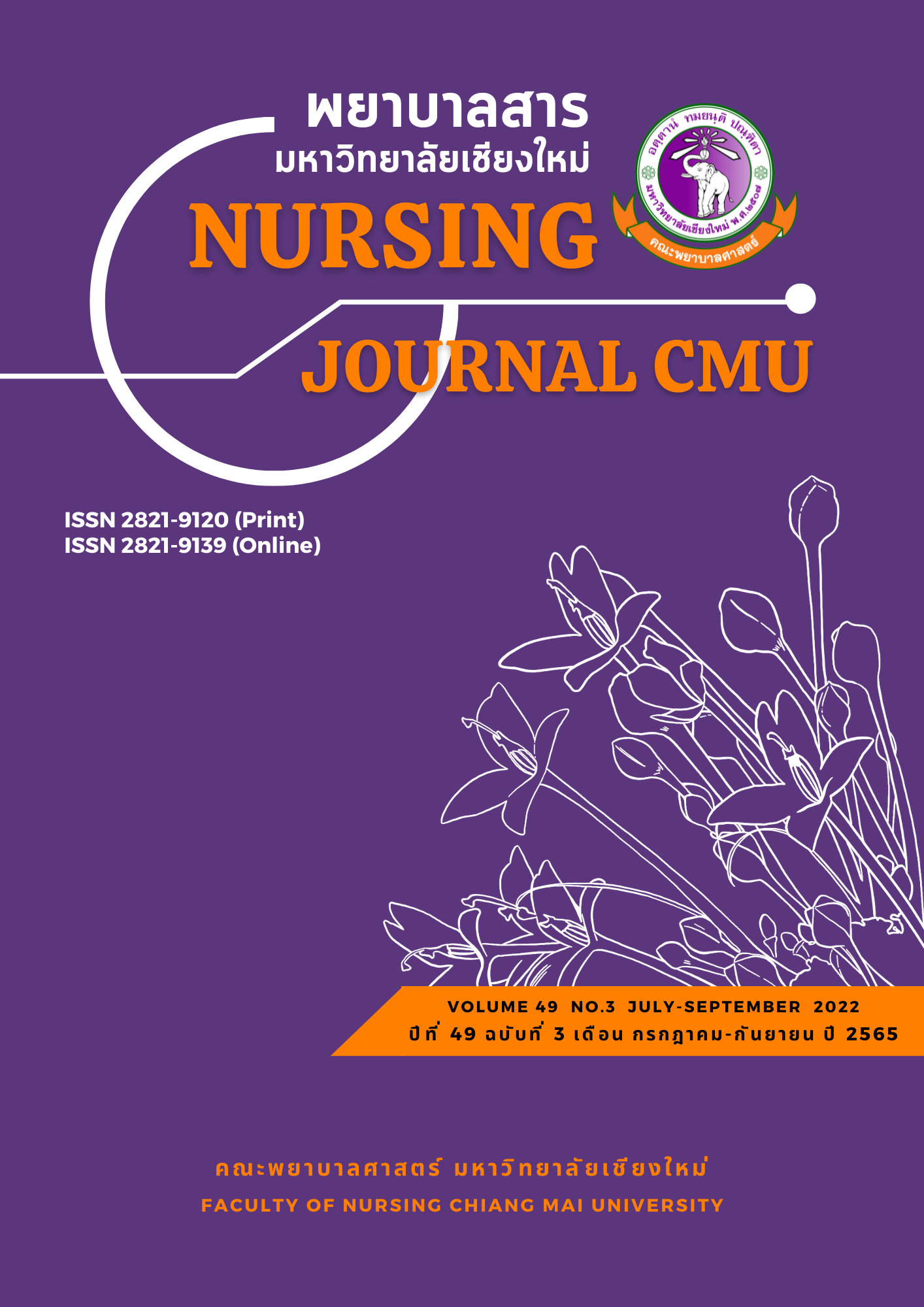Effects of a Self-management Program Among Patients with Ischemic Stroke
Keywords:
Self-management program, Ischemic stroke, Self-management behavior, Clinical outcomesAbstract
This study used a quasi-experimental research design with pretest-posttest control groups. The objective of the study was to evaluate the effects of a self-management program among ischemic stroke patients. The study was undertaken at a university hospital. Sixty acute stroke patients were recruited for the study, and they were then assigned to an experimental group (n = 30) or a control group (n = 30). The experimental group received the self-management program, designed based on the concept of self-management by Creer (2000), from the researcher, whereas the control group received usual care by the nursing staff. The outcomes were evaluated at baseline and 8 weeks. The instruments used in the study were the demographic questionnaire; the clinical outcomes, including blood pressure, blood glucose, and lipid profile; and the self-management behaviors test. Data were analyzed using descriptive statistics and the independent t-test.
The findings showed that the mean score of clinical outcomes in the experimental group increased with statistical significance and was greater than the mean score of clinical outcomes in the control group and greater than at baseline (p <.001). The mean score of self-management behaviors in experimental group increased with statistical significance, and was greater than the mean score self-management behaviors in the control group and greater than at baseline (p <.001).
The results demonstrated that the self-management program can increase clinical outcomes and self-management behaviors in ischemic stroke patients. Nurses and healthcare team can apply this program to improve quality of care among stroke patients.
References
Areechokchai, D., Vijitsoonthornkul, K., Pongpan, S. & Maeakhian S. (2017). Population attributable fraction of stroke risk factors in Thailand: Utilization of non-communicable disease surveillance systems. Outbreak, Surveillance & Investigation Reports, 10(1), 1-6.
Bailey, R. R. (2018). Lifestyle modification for secondary stroke prevention. American Journal of Lifestyle Medicine, 12(2), 140-147.
Boger, E. J., Demain, S., & Latter, S. (2013). Self-management: A systematic review of outcome measures adopted in self-management interventions for stroke. Disability and Rehabilitation, 35(17), 1415–1428. doi.org/10.3109/09638288.2012.737080
Chodosh, J., Morton, S. C., Mojica, W., Maglione, M., Suttorp, M. J., Hilton, L., … Shekelle, P. (2005). Meta-analysis: Chronic disease self-management programs for older adults. Annals of Internal Medicine, 143(6), 427–438. doi.org/10.7326/0003-4819-143-6-200509200-00007
Creer, L. T. (2000). Self-management of chronic illness. Handbook of self-regulation (pp.601-629). California: Academic.
Fu, D., Fu, H., McGowan, P., Shen, Y. E., Zhu, L., Yang, H., … Wei, Z. (2003). Implementation and quantitative evaluation of chronic disease self-management programme in Shanghai, China: Randomized controlled trial. Bulletin of the World Health Organization, 81(3), 174-182.
Gorelick, P. B. (2019). The global burden of stroke: Persistent and disabling. The Lancet Neurology, 18(5), 417-418.
Kleindorfer, D. O., Towfighi, A., Chaturvedi, S., Cockroft, K. M., Gutierrez, J., Lombardi-Hill, D., … Williams, L. S. (2021). 2021 Guideline for the prevention of stroke in patients with stroke and transient ischemic attack: A guideline from the american heart association/american stroke association. Stroke, 52(7), e364-e467.
Neurological Institute of Thailand. (2019). Clinical practice guidelines for ischemic stroke. Bangkok: Tana press. (in Thai)
Ritklar, L., Wattana, C., & Kitipawong, P., (2012). Effects of a self-management program on self-management behaviors, dyspnea, activities of daily Living, and quality of life among patients with congestive heart failure. Nursing Journal, 39(1), 64-76. (in Thai)
Srisatidnarakul, B. (2010). The methodology in nursing research. Bangkok: U & I inter media. (in Thai)
Suwanwela, N. (2014). Stroke Epidemiology in Thailand. Journal of Stroke, 16(1), 1-7. doi:10.5853/jos.2014.16.1.1
Thatsaeng, B., Lasuka, D., & Khampolsiri, T. (2012). Effects of a self-management supporting program on self-management behaviors and blood pressure among elders with hypertension. Nursing Journal, 39(4), 125-137. (in Thai)
Wang, Y. L., Pan, Y. S., Zhao, X. Q., Wang, D., Johnston, S. C., Liu, L. P., … investigators, T. C. (2014). Recurrent stroke was associated with poor quality of life in patients with transient ischemic attack or minor stroke: Finding from the CHANCE Trial. CNS Neuroscience & Therapeutics, 20(12), 1029-1035.
Wattana, C., Srisuphan, W., Pothiban, L. & Upchurch, S. (2007). Effects of a diabetesself-management program on glycemic control, coronary heart disease risk, and quality of life among Thai patients with type 2 diabetes. Nursing and Health Science, 9(2), 135-141. (in Thai)
Downloads
Published
How to Cite
Issue
Section
License
Copyright (c) 2022 Nursing Journal

This work is licensed under a Creative Commons Attribution-NonCommercial-NoDerivatives 4.0 International License.
บทความที่ได้รับการตีพิมพ์เป็นลิขสิทธิ์ของวารสารพยาบาลสาร
ข้อความที่ปรากฏในบทความแต่ละเรื่องในวารสารวิชาการเล่มนี้เป็นความคิดเห็นส่วนตัวของผู้เขียนแต่ละท่านไม่เกี่ยวข้องกับมหาวิทยาลัยเชียงใหม่ และคณาจารย์ท่านอื่นๆในมหาวิทยาลัยฯ แต่อย่างใด ความรับผิดชอบองค์ประกอบทั้งหมดของบทความแต่ละเรื่องเป็นของผู้เขียนแต่ละท่าน หากมีความผิดพลาดใด ๆ ผู้เขียนแต่ละท่านจะรับผิดชอบบทความของตนเองแต่ผู้เดียว






